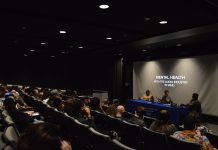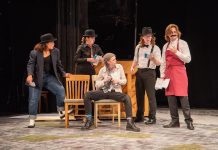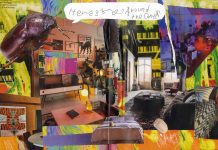The Journal shares a few of their favorite Webster faculty and staff spaces

We at The Journal have conducted countless interviews with administrators, faculty and staff on campus. Thus, we’ve stepped into a lot of offices and in some, we’ve found ourselves intrigued and inspired by the intricacies, knickknacks and art that lined the walls. Here are just a handful of our favorites.
Peter Sargent
Peter Sargent, dean of the College of Fine Arts, works in what was once the Thompson House solarium (a sunroom) where the original homeowners used to grow greenery and flowers. Though Sargent’s first office was in the Loretto-Hilton Center, he is now located in this house, now the Music Building.
The Thompsons, the original homeowners, used the surrounding acres for vast gardens. The solarium, still with its old green tile floors intact, stood as Mrs. Thompson’s sunroom.
A stone fountain once stood in front of the three-paneled bay windows surrounding Sargent’s office. The separation of tile, once the fountain was removed, can still be seen.
After it became the Music Building, the space was used as a listening room. Students could listen to music they were currently studying at six tables with headsets. About 10 years ago, it became the dean’s office.
A bookshelf lines most of the wall, but Sargent desired a way to put up his art, his photos and his memories.
His wife, an interior decorator, came up with what Sargent agrees is an ingenious idea. Using a gold chain, the kind used in toilets, they strung together framed photos of family and friends, as well as small posters and novelties from his students’ past Conservatory shows. Then, they hung the long chains in front of each set of windows.
Near the entrance to Sargent’s office sits a Grandfather clock, a prop used in the Conservatory’s performances of “Threepenny Opera.” Most of the chairs in Sargent’s office were used as props, too. An old folding chair plucked from Loretto-Hilton Theatre sits near his desk. The artwork in his office is all student-made.
“My office is a collection representing my time at Webster University,” he said.

Elizabeth Stroble
President Stroble’s spacious office, located in Loretto Hall, has glass doors at its entrance and rich hardwood floors. A secondary door leads to a separate conference room with a long table and chairs. Before it became the office of the president, and perhaps the most attractive office on campus, it served as a residence hall for students, equipped with dorms and lounges.
In her first year as president, Stroble held open houses in her suite.
“There were people who came to these open houses who remembered when they were students staying up late playing Dungeons & Dragons in those lounges,” Stroble said. “It’s very fun for me to think that I’m living in space that once was used by students.”
Stroble said the office gives off nothing but good vibes and the setting is a fitting match to her optimism and outlook.
“It’s so bright and light, and very soothing and welcoming,” she said.
Large bookshelves line Stroble’s office walls. She stocked the shelves with her full collection of professional books when she arrived at Webster, something she was never able to do at previous jobs.
Perhaps her favorite office items are a set of book-ends that are a plaster-cast of Loretto Hall. Her husband gave them to her right after they moved to St. Louis.
“He found them and surprised me with them,” she said. “It’s kind of my connection to Webster, through an unusual source.”
Mementos from her trip s to China and South America (“International Flair,” as she likes to call them) dot her walls, as well as artwork from all the cities she’s lived and worked in over the years.
“I’m fortunate to have an office that Webster had designed presumably at least a couple presidents ago, and I get to enjoy it,” she said. “I didn’t really do anything to it except bring my personal books, art and artifacts.”

David Clewell
David Clewell, Missouri Poet Laureate and Webster English professor, has worked from the same office in Pearson House for the last 26 years. Hiding in the corner of the second floor, Clewell’s office is small and cramped — packed from ceiling to floor with endless bookshelves brimming with books, pictures, old notebooks, vintage toys and signs. To put it simply, the color of Clewell’s office walls is a question, as something covers nearly every inch of wall space.
“I’m an ‘accumulator,’” he said.
He recalls the first item that went up in his office. A sign hanging on a bulletin board to the right of his only window reads, “WAITRESS WANTED” in bold, black letters. He got it from a New Jersey diner, right out of the storefront. Another sign contributing to the room’s randomness reads, “If it works, it’s obsolete.” An “I Like Ben” pin is stuck in the clutter and an “Allen Ginsburg Toy” still smiles from its box.
Not everything in Clewell’s office is entirely random, however. A major theme among his accumulations is also one of his favorite curiosities — aliens. Various alien odds and ends riddle his walls; on the back wall sits a plastic bowl shaped as an alien’s head that once held Alien Pops candy, a stuffed alien dangles from a bookshelf and bumper stickers and pictures are stuck to the front of his door.
A yellowed, deep-seated chair with rubbed and frayed edges is the unofficial spot for students or guests. To the left of the chair and under the window sags Clewell’s old desk, blanketed with paper stacks, books and a computer (though he prefers to do most of his writing on a typewriter).
Clewell said if he really had to, he’d “thin the herd,” and be rid of some of his prized clutter. But he’s not a fan of the idea.
“It’s too much, but I need it,” he said. “The stupider, the better.”



